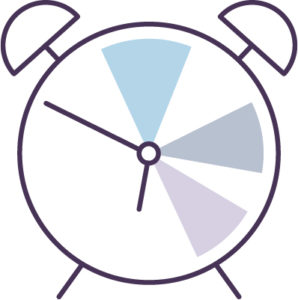As part of a typical CBTi program, each morning you will record information about your sleep in a sleep diary or a sleep tracker. At the end of each week, you will estimate your sleep numbers for your typical night’s sleep of the previous week. You can do this yourself if using a CBTi workbook or other pen and paper method, or the numbers will be calculated for you if you are using a digital program such as an online CBTi program or app. Use these numbers to track changes in your sleep as you progress through the CBTi program.
SLEEP NUMBERS
There are four sleep numbers to track.
Sleep window
The amount of time between getting into bed for the night and getting out of bed to start your day.
Time awake
The total amount of time you were awake between getting into bed for the night and getting out of bed to start your day.
Time asleep
The total amount of time you slept between getting into bed for the night and getting out of bed to start your day.
Sleep efficiency
The ratio of your time asleep compared to your sleep window. The target is 85% to 95%.
The easiest way to estimate your sleep numbers is to use Sleepwell’s online Sleep Calculator.
SLEEP SCHEDULE
Most CBTi programs use an adjustable sleep schedule to improve your sleep efficiency. You start by choosing your bedtime and rise time.

Your bedtime should be the time when you usually feel tired and ready for sleep. Your rise time is the time that you will get out of bed to start your day each morning for the next week. At the end of each week, your sleep schedule changes based on your sleep numbers. If you are spending a lot of time in bed awake, the sleep schedule for the next week will reduce your time in bed. If you are sleeping most of the time that you are in bed, your sleep schedule will give you more time in bed.




